:: Artistic Researcher (PhD) ::
Bertrand Chavarria-Aldrete - Artistic Researcher (PhD)

© Marco Giugliarelli for Civitella Ranieri
After a Master Degree in Fine Arts at Universidade do Porto (Portugal), Bertrand Chavarría-Aldrete continued his career as an artistic researcher obtaining a PhD in Fine Arts in Music Performance at Lund University (Sweden).
His research called Plastic Extension of Music is focused on the plasticity of music and how this aspect can take different forms to interact with society, creating three different Artistic Research tools:
-
Plastic Extension of Music as a creative tool for music performers to explore the plasticity of music with materials issued from other disciplines, today an official course at Lund University;
-
The Kléndinsky Test: an artistic research project aimed to learn tactile and “visual” perspectives of tuned sound from the blind and the visually impaired to transcribe music for the deaf and the hearing impaired;
-
NABÔKÔ, a sculptural audiovisual language of 24 organic shapes.
His research has been recognized by the international press (France, Germany, France, Portugal, Mexico…) and radio; awarded the prize of "Research of the Month" by The Royal Swedish Academy of Music (2021) and lately nominated for the "Forskar Grand Prix” (2025) in Sweden.
The research outputs called Plastic Extensions, have been exposed at different art galleries and artistic research centers in France, Sweden, Germany, Portugal or Spain.
An active polyglot international lecturer (Sorbonne, ELIA, Uniarts, KTH - Royal Institute of Technology, Arkitektskolen Aarhus...), he has presented and discussed different subjects in the form of lectures and conferences of his own research Plastic Extension of Music, as well as: sustainability in art, music pedagogy, sound art, muscle memory, special needs, the cultural structures or even a performative lecture for music composers about the extended techniques and sound possibilities of the guitar.
Deeply interested to learn from different audiences and social marginalized sectors, he dedicates an important part of his life to compose inclusive music works and performances with special needs: (de)cor(o), the elderly: forassa, or children: sc(herz)o infinito, while conducting research and conducting and designing a series of new inclusive music workshops all over Europe.
Chavarría-Aldrete has been recipient of different research grants: Carl Swartz minnesfond, Kungl. Musikaliska Akademien, Sound Environment Centre LU and Vinnova.
From 2006 until 2016, he was the general director of the cultural structure SMASH in Salamanca and San Sebastian/Donostia in Spain. Lately, in 2024, he was the director of the first International Seminar on blindness and deafness in music and art that took place at Inter Arts Center from Lund University in Malmö, Sweden, with international guests from Japan, UK, Austria, France, Denmark and Sweden.
Selected Solo exhibitions
Galerie Les limbes (France) Inter Arts Center (Sweden), Galería Rua do Sol, Centro Portugués de Fotografía, Fábrica da Criatividade (Portugal), Centro Cívico Las delicias, Centro José Luis Mosquera (Spain).
Selected Collective exhibitions
Skissernas Museum (Sweden), Internationale Klangbasierte Künste, re:future Lab, HilbertRaum, ReTramp (Germany), Forum de Maia, GNRation, Faculdade de Belas Artes de Porto, Encontrarte (Portugal).
Selected Conference Venues
Universidad Autónoma de Nuevo León, Universidad Autónoma de Guanajuato, Universidad de Michoacán (Mexico). Universidad de Salamanca, Universidad de Valencia, Musikene, Universidad del País Vasco (Spain). Université de la Sorbonne, Université de Saint-Etienne (France). Faculdade de Belas Artes - Universidade do Porto, Faculdade de Belas Artes - Universidade de Lisboa, Escola Superior de Música de Lisboa, Universidade de Évora (Portugal). Inter Arts Center, Skisernass Museum, Lund University, Dalarna University, KTH Stockholm (Sweden), Uniarts (Finland), Arkitektskolen Aarhus (Denmark).
External Links:
Plastic Extension of Music

Plastic Extension of Music is an artistic research project created by Bertrand Chavarría-Aldrete, that explores alternative methods to perform score-based Western art music based on the particularity of the performer as “creative critic” of the score.
This new practice is a response to extend the artistic significance of the performer of this music, in a world where tradition imposes a perpetuative and canonical model of performance. A model that suffers from digital reproduction inside an oppressive socio-economic situation for the music performer.
The fundamental idea of the exploration starts from the detection of the performer's plasticity in connection with the music score. This intervention in the traditional performance, triggers a poietical phase to imagine new ways to perform music in space instead of time, through the employment and manufacture of materials issued from different disciplines; resulting in new performances in the form of metaphorical containers, emerging as installations, paintings, drawings, sculptures, video works, etc.
Plastic Extension of Music is since 2025 an official course at Lund University (Sweden) at the Faculty of Fine and Performing Arts, conducted by Bertrand Chavarría-Aldrete.
External links:
Other links:
Plastic Extensions by Bertrand Chavarría-Adrete
[Research outputs]
voids
[Sculptures]
(2025)
Le geste et son double
[Painting and shadow installation]
(2023)
carminic tensor [292 paintings]
(2022)
specchio di perfezione [light installation]
(2022)
sempre morbida [sculpture]
(2021)
coyote [drawing]
(2017)
fuga (soiseubuda) [video]
(2015)
quintillo y paisaje
[Painting and video installation]
(2025)
camisa de once varas para un antropomorfo
[string installation]
(2023)
(in)habit [video]
(2022)
Rihmstrom [Paint installation]
(2022)
tientos topográficos :: tacto temperado [installation]
(Work in progress)
The Kléndinsky Test

Image from the workshop "The Kléndinsky Test" at Inter Arts Center (Sweden)
The Kléndinsky Test is an artistic research project created by Bertrand Chavarría-Aldrete, aimed to learn tactile and “visual” perspectives of tuned sound from the blind and the visually-impaired, and measure this knowledge against the scientific and pedagogical history of blindness with the input of Dr. Jan Eric Olsén. The objective is to unveil the physical and (in)visible form of music, to use these forms in the development of new methodologies of music transcription through the plasticity of music. The result will be a new music language conceived for the hearing-impaired and the deaf.
The project is carried out by a series of interviews, workshops and a specially designed test, The Kléndinsky test. The activities reassess historical ways of working with the problem of sight/blindness, and open up for visually impaired to influence the artistic creation. They teach us to “see” the physical associations of tuned sound through tactile perspectives and imagination.
An example of the preliminary data gathered in 2022 can be seen in the documentary "Unveiling the invisible" directed by Bertrand Chavarría-Aldrete and Gonçalo Duarte.
Unveiling the invisible [2022]
[documentary - 17:01 min]
(This film is available only on demand, go to the contact page)
A documentary film by Bertrand Chavarria-Aldrete & Gonçalo Duarte
How does sound look like ? Ana and Carla, both visually impaired, tell us how they “see” and feel sound. This short documentary is a fragment of how sound seems to unveil its mysterious form through the hands and “visions” of the visually impaired.
2 minute extract of the documentary "Unveiling the invisible" © Chavarría-Aldrete & Duarte. All rights reserved
NABÔKÔ

NABÔKÔ is a music-sculptural language created and designed by Bertrand Chavarría-Aldrete. An audio-tactile-visual tool of 24 organic shapes, representing each a musical note, to create infinite sound representations as structures.
The origin of this new tool is the result of a creative process that started from experimentation, the use of historical references, the imprint of the plasticity of the music gesture and the negative spaces of the hand, culminating in this new audio-tactile-visual language.
This tool made of 24 organic and reproducible shapes, represent each a musical note (including the quarter-tones), to freely create tactile-visual structures, an inclusive, intuitive and open-ended tool.

NABÔKÔ: Do-Mi-Sol-Si-Re chord © Bertrand Chavarría-Aldrete

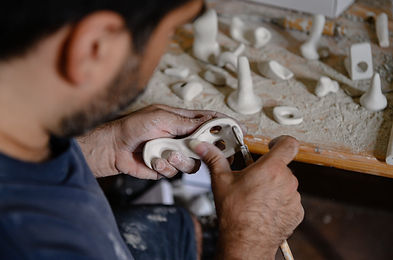
Bertrand Chavarría-Aldrete, creating and shaping the figures at the Civitella Ranieri Foundation in Italy © Marco Giugliarelli for Civitella Ranieri

NABÔKÔ © Bertrand Chavarría-Aldrete
Designed Music Workshops*
*To organize one of these workshops at your school or institute, please contact Bertrand Chavarría-Aldrete at the contact page on this website
Triggering sounds and words [Memory] (2024)
Workshop for special needs, Alzheimer patients and elders
Duration: sessions can be of 30 minutes or 1 hour
Type: collective or individual
Music: Live music in different formats can be considered
Interaction with participants: Small instruments and texts (material will be brought by Chavarría-Aldrete). A consent form will be agreed with the institute or center before the workshop.
A chamber music interactive workshop conceived for live musicians performing with the music and vocal interventions of seniors and elders, Alzheimer patients and special needs. Music and poetry by Bertrand Chavarría-Aldrete, is performed and recited live with the purpose to trigger memories with the sound, the words and the gestures, inside an empathetic and harmonic environment.
The first workshop was organized by Musique et Patrimoines en Charolais-Brionnais during their unisSONS season in France. The workshops were held at Établissement d'hébergement pour personnes âgées dépendantes Champrouge in Mazille, Association Bien Vieillir in Val de Joux and Maison d’Accueil Spécialisé Le Replat, in Bergesserin.
Interested in organizing this workshop? Go to the contact page

Triggering sounds and words [Memory] session. © unisSONS
Plastic Extension of Music Workshop (2024)
Workshop for musicians to explore different forms of art
Duration: Different formats available: from 1 week to a trimester or one scholar year
Type: collective
Music: Performance from the participants
Interaction with participants: A series of lectures are given, collective and individual sessions, depending on the format an exhibition of the Plastic Extensions can also take place.
A workshop conceived for musicians, that aims to introduce and help create a “Plastic Extension” of a musical piece. Each participant musician should choose a piece that wishes to extend into other media, such as painting, video, sculpture, installation or any other “media” outside the instrument. The material to be extended could be issued from the embodied knowledge developed with the score, the score itself, technical difficulties, a memory gap…or any other aspect that we can think it can be translated into another form of art, avoiding the “staging” of the piece; the goal is to create different spaces and ideas for music performance.
The first workshop took place during the scholar year 2023-2024 at Inter Arts Center in Malmö, Sweden.
Interested in organizing this workshop? Go to the contact page

Plastic Extension of E. Bozza's Caprice nº 3, created by Sofia Vecchiato
The embodiment of sound (2022)
A workshop for performers embodying sound
Duration: 3h
Type: Public and collective
Music: Performance from the participants
Interaction with participants: The participants will express the sounds and the public will analyse and discuss at a final session. A consent form will be agreed before the test.
The performance of a musical piece is to put the body in motion trans-forming, de-forming and in-forming the musical text. Trans-forming the text to a particular body gesture or movement, de-forming a visual shape to a sound and in-forming the text in the open. These three forms are the basis to per-form a musical piece. Once the performer has embodied the information, finally dresses up in the musical text, putting in motion the body contracted/freed by the codes written on the score.
This workshop is designed to experience live and study how our bodies translate directly sound signals into gestures, comparing and discussing the results with the participants.
The first workshop took place the 23rd of February 2022 at Inter Arts Center in Malmö, Sweden.
Interested in organizing this workshop? Go to the contact page
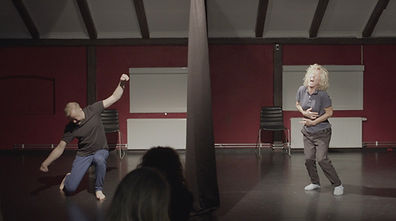
Workshop "The embodiment of sound" at Inter Arts Center
Unveiling the invisible (2022)
Workshop for the blind and the visually impaired
Duration: 4h
Type: Individual
Music: Recorded sounds
Interaction with participants: The participants will express the sensations verbally and physically of the recorded sounds. A consent form will be agreed with the participant before the test.
A workshop for the visually impaired and the blind issued from the research ‘Plastic Extension of Music’ that aims to create a new catalogue of sounds in different outputs and associations with the help and collaboration of participants from the visually impaired and the blind communities.
“Unveiling the invisible” is an artistic research project aimed to learn tactile and “visual” perspectives of tuned sound from the blind and the visually impaired. The objective is to unveil the physical and (in)visible form of music, to use these forms in the development of new methodologies of music transcription through the plasticity of music. The result will be a new music language conceived for the hearing-impaired and the deaf.
This project is carried out by a specially designed test an artistic research tool called The Kléndinsky test. The activities inside the test, reassess historical ways of working with the problem of sight/blindness, and open up for visually impaired to influence further artistic creations. They teach us to “see” the physical associations of tuned sound through tactile perspectives and imagination.
The first series of workshops took place in October 2022 at Inter Arts Center in Malmö, Sweden.
Interested in organizing this workshop? Go to the contact page
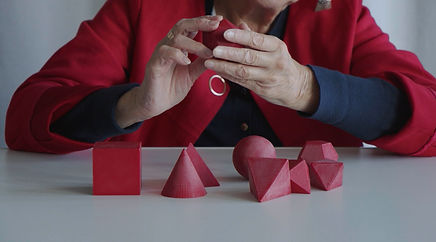
Image from the workshop "Unveiling the invisible" at Inter Arts Center (Sweden)
(de) cor (o) (2019)
Music workshop for special needs
Duration: 1-2 weeks
Type: collective
Music: Live performance
Interaction with participants: The participants will imitate and express the sensations verbally and physically of the recorded sounds to create the first material. A need to foresee a series of rehearsals with the participants need to be considered before a live performance. A consent form will be agreed with the participant before the test.
(de)cor(o) is a performance device for special needs with electroacoustic sounds and instruments, that is created in three phases.
The first phase starts by creating an electroacoustic material that is issued and derived from the personality traits and qualities of each person, treated as musical gestures and musical objects. These musical objects organized in time, create an electroacoustic “figured bass” or “basso continuo” (an accompanying part that includes a bassline and harmonies, typically played on a keyboard instrument and with other instruments such as cello or lute.), which will be the soundscape of the performance.
In the second phase, this electroacoustic material is reworked, re-interpreted, recomposed, recorded and treated to create a new sound material to be integrated into the soundscape of the performance.
The third phase is the final performance, where all the participants perform live (following a conductor) over the soundscape.
The first workshop took place at the Festival Encontrarte in Amares (Portugal) at the CAO (Special needs residence) in July 2019.
Interested in organizing this workshop? Go to the contact page
Live performance at Festival Encontrarte in Amares, Portugal the 27th July, 2019.
Building & Interpreting (2013)
Music and creative workshop for children
Duration: 1-2 weeks with 5 sessions, performance and concert
Type: collective
Music: Live performance
Interaction with participants: The participants (Children) will imagine, design and create a music instrument issued from a graphic score. Drawing and small crafting is required from the participants.
The main objective of the workshop is the interpretation/reaction of graphic scores in the vision of children, with the purpose to learn but also create, new and innovative ways to approach and perform these scores. The children first approach the graphic score, they study it, understand it and talk about it. The second step is to invent an instrument to “perform” the music score, by drawing it and then explain the methodology of their creation and its relation with the score. Once the design is made, in the third step, children build their own instrument with the help of their parents, teachers and myself. The fourth step is to learn the performance of the score with the instrument and use all the features designed in it to finally exhibit the instruments and perform live the graphic scores on a concert.
The first workshop took place in 2013 at the Orixe Ikastola de Donostia (San Sebastian) in Spain and was presented during the VII Festival Internacional SMASH de Música Contemporánea.
Interested in organizing this workshop? Go to the contact page
Video from the project at VIII Festival Internacional SMASH de Música Contemporánea 2013
Draw me a piece of music (2008)
Music and drawing workshop for children
Duration: 2 hours and concert
Type: collective
Music: Live performance with 4 musicians
Interaction with participants: The participants (Children) will compose a new music piece by drawing. The possibility to draw is required from the children, parents or tutors can assist and help the children.
The main purpose of “Draw me a a piece of music” is to bring a contemporary and experimental musical language to children through gestures and imitations. The composer Salvatore Sciarrino works on the composition of his works directly with strokes and movements in a time plane that is divided into seconds. This way of working allows him and the auditor to “see” the sound traces when listening to his works. That is how; Inspired by Salvatore Sciarrino's way of working, this workshop was created.
Using “Esplorazione del Bianco II” by Salvatore Sciarrino for flute, clarinet, guitar and violin as source for those gestures and strokes that are visible/audible, we extract these gestures, strokes and traces to translate them into visual representations of noises, onomatopoeias and objects that are familiar to children between 6 and 12 years old. With this visual catalog of sound "possibilities" they can draw a "score" (time plan in seconds for the musicians to perform) and place/compose their sounds/drawings at their own will, creating a graphic score to be performed by the musicians live.
The first workshop took place in Salamanca, Spain during the III Festival Internacional SMASH de Música Contemporánea.
Interested in organizing this workshop? Go to the contact page
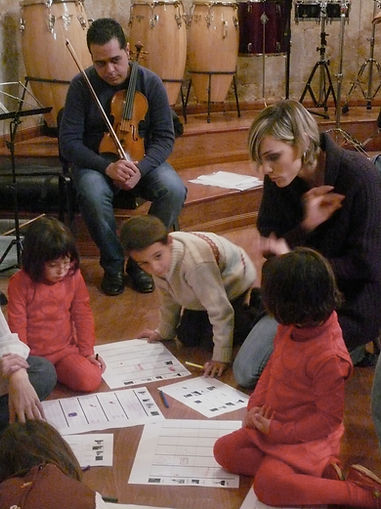
Image from the workshop "Draw me a score" during the III Festival Internacional SMASH de Música contemporánea in 2008.
Conferences
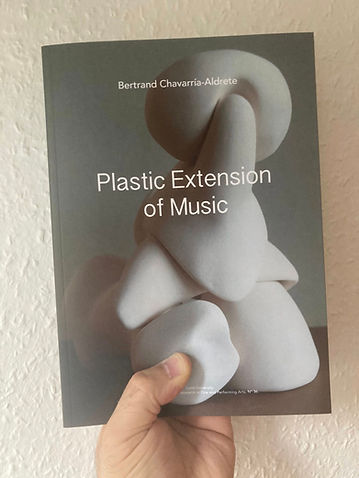
Plastic Extension of Music
Abstract:
Plastic Extension of Music is a creative tool for performers to deactivate the historical weight of the praxis in classical music, creating new ideas, grounds and platforms for a different kind of performance. These new metaphorical vehicles allow the performer with its hands to translate the language, gestures and embodied knowledge outside the instrument in other forms of art, rethinking the music and the performance, while emancipating classical music and its performers from our long tradition.
The creative criticism inside Plastic Extension creates infinite and autopoietic methodologies to approach the performance of classical music, allowing an expansion of the music outside the instrument, deepening the practice and creating new knowledge from a different perspective: the plasticity and embodied knowledge of the musical gesture.
This conference was presented at:
International seminar: Darkness and Silence (2024)
Inter Arts Center (Sweden)
ELIA Academy - Évora 2023: Exploring situatedness
Universidade de Évora (Portugal)
Sound and Music Interaction Seminar (2023)
KTH Royal Institute of Technology, Stockholm (Sweden)
CA2RE AARHUS (Community for Artistic and Architectural Research): Exchanging (2023)
Aarhus School of Architecture (Denmark)
ELIA Biennial Conference 2022
NO STONE UNTURNED EXTENDING TRANSDISCIPLINARITY
Uniarts, Helsinki (Finland)
Artistic Residency Queue de Cérise (2022)
Faculté de Beaux-Arts of Université Jean Monnet, Saint-Étienne (France)
Extensión Plástica de la Música (2022)
Centro de las Artes - Monterrey, Nuevo León (Mexico)
Festival Internacional de guitarra de México (2022)
Saltillo (Mexico)
Towards the Sound Festival (2022)
HilbertRaum Gallery, Berlin (Germany)
PhD Conference on Sustainable Development (2021)
LUCSUS - Lund University Centre for Sustainability Studies (Sweden)
"Pulsações dilatadas” - Uma extensão da música nas artes plásticas (2020)
("Dilated Pulsations” - An extension of music in the visual arts)
FBAUL - Faculdade de Belas-Artes da Universidad de Lisboa (Portugal)

Guided by the blind to play for the deaf
Abstract:
Guided by the blind to play for the deaf is an artistic research project aimed to learn tactile and “visual” perspectives of tuned sound from the blind and the visually impaired, and to measure this knowledge against the scientific and pedagogical history of blindness. The objective is to unveil the physical and (in)visible form of music, to use these forms in the development of new methodologies of music transcription through the plasticity of music. The result will be a new music language conceived for the hearing-impaired and the deaf.
The project is carried out by a series of interviews, workshops and a specially designed test, “The Kléndinsky test”.
This conference was presented at:
International seminar: Darkness and Silence (2024)
Inter Arts Center (Sweden)

Sound Art in the last 20 years
Abstract:
A presentation and analysis of different outputs in Sound Art from the last 20 years. Works from: Nam June Paik, Rebecca Horn, Erwin Wurm, Heiner Goebbels, Julijonas Urbonas, Timo Kahlen, Céleste Boursier-Mougenot, Susumu Shingu, Anna Jermolaewa, Paul DeMarinis, Pierre Laurent Cassière, Susan Philipsz, Server Demirtaş, Jordan Wolfson, Theo Jansen, Sarkis, Cory Arcangel, Christian Marclay, Pierre Huyghe and Sean Reynard AKA Quentin Smirhes.
This conference was presented at:
Plastic Extension of Music Workshop (2023)
Inter Arts Center, Malmö (Sweden)

Gestures in Plastic Extension of Music, a new artistic thinking
Abstract:
The deeper we go and practice Classical Music, the more social, economical and historical obstacles we encounter. As heirs of the classical music tradition, a “secret protocol between generations” is established in which we are left with the “weak messianic power” to live and develop a practice attached to a different time, a more prosperous era in which the economical exchange of music was not intervened by world wide distribution and neoliberal labor practices.
Young classical musicians find themselves with an instrumental knowledge, an embodied knowledge that has been transmitted for nearly a millennia to perform inside the canonical laws of classical music, laws mainly dictated on the 19th Century and “mannerised” over the last years towards an artificial perfection, a dying art of music performance, currently instructed at every Conservatory and Music Academy, that does not belong to the current socio-economical exchange.
This conference was presented at:
Gestures and Languages: Innovative Approaches to Artistic Thinking and Pedagogy (2023)
University of the Arts Helsinki (Finland)
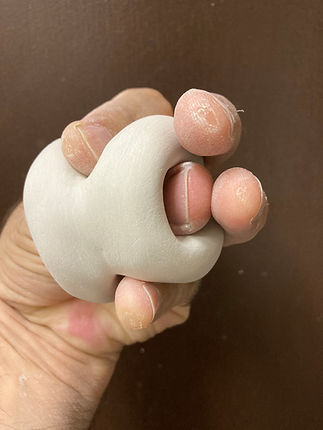
( · )forming Muscle memory
Abstract:
My research on plastic extension of music has led me to understand that a series of gestures imprinted on my work are issued from the muscle memory developed in practice and performance. During the creation of some “extensions” I detected that a series of technical and musical problems inside the performance of the “extended” piece have found a solution and different performance when taking them out of the musical context, putting them into space and fixed in time.
Creating a new interpretation in a different support outside the musical environment not only to create a different perspective but to have “degree zero” performance independent of the muscle memory and translation of the codes in the musical score.
This paper has the objective of understanding the role of the performer as a translator of a series of codes and how these codes are embodied by the performer, creating inevitably muscle memory and habits “Our only way to interact with the world around us is by generating movements; therefore motor learning can in a sense be regarded as the most fundamental form of learning process”.
Is it relevant to consider the output of a performance as a series of translations?
Do these interpretations (translations) really belong to us, or are they just a series of common positive events that build and construct a pragmatic environment?
A series of examples on how information from different sources is embodied will be shown during the presentation with the intention of showing that our consciousness is deliberately formed by our surroundings and environment.
This conference was presented at:
Musikforskning idag 2022
Högskolan Dalarna, Falun (Sweden)

In-situ: (de)cor(o)
Abstract:
In 2019 I was invited by the Encontrarte Festival in Portugal to create a performance with residents of the Valoriza center (Center for people with special needs) in the town of Amares.
After a first contact and a series of personal interviews with the residents to know their personality, I decided to develop a performance device with an electroacoustic material derived from their qualities, treated as gestures and musical objects in the work, unique creative and interpretive particularities. This electroacoustic material will be reworked, re-interpreted, recorded and recomposed a few months later, during two weeks of work, to be created during the festival.
This experience, in conjunction with my research on “The plastic extension of music”, allowed me to observe the effect, the repercussion and empathy of the sound signal in the body. I propose to present the creative process and the particular aspects of this electroacoustic work which functions as a liberating gesture of creation and social-artistic paradigms.
This conference was presented at:
"La création musicale en question" of the SIMC 2022
Paris-Sorbonne University (France)
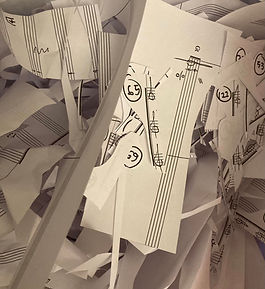
“Bússola rota” - A composição é para perder-se (“Broken Compass” - Composition is for getting lost)
Abstract:
Carolyn Carlson says, “We are all suspended without definition”. I don't know where I come from or where I'm going, I try to get lost and I really enjoy it. Composition is a tool to get lost, to get out of the concrete, the fixed. Creating music is looking at a broken compass with the hope that it never indicates a right path, the end of the search, the end of the journey.
The paper will explain the different techniques of applied artistic research inside composition and new innovative tools for opening new paths of knowledge and art with special needs.
This conference was presented at:
ESML - Escola Superior de Música de Lisboa (Portugal) (2020)

Cultural Structures, the dark side of art
Abstract:
The "do's and don'ts" on the cultural structures. How to build honest cultural structures in diverse environments in the XXI century.
A lecture that displays the comparison between new and historical cultural structures and the tools and techniques to adapt new cultural content inside society with the official support of public grants. The examples come from personal experience, but also from research done on the management field and new structures that have succeeded but also failed.
Irony, dark humor, and many ideas for people that are interested in the management of modern cultural structures.
This conference was presented at:
Cómo ser tu propio manager (2015)
Conservatorio Superior de Salamanca (Spain)
IX Festival Internacional SMASH de Música contemporánea (2014)
Universidad del País Vasco (Spain)
SMASH ensemble - Proyectos pedagógicos (2012)
Universidad de Michoacán (Mexico)

Novum Organum
Abstract:
A lecture on the new perspective of the guitar, showing a new vision of the instrument with live extracts of the extended techniques used for the guitar in the XX and XXI repertoire. This performative conference is aimed for guitarists who which to understand the organicity and technical deconstruction of the new techniques as well as for composers who wish to compose and integrate new sounds for the guitar and similar plucked-string instruments.
Live performance extracts from: Helmut Lachenmann, Brian Ferneyhough, Rebecca Saunders, José Luis Torá, Ramón Lazkano, Fernando Fiszbein, amongst many others.
This conference was presented at:
VIII Festival Internacional SMASH de Música Contemporánea (2013)
MUSIKENE, Higher School of Music of the Basque Country (Spain)
SMASH ensemble - Proyectos pedagógicos (2013)
Conservatorio de Torrelavega (Spain)
SMASH ensemble - Proyectos pedagógicos (2012)
Facultad de Música - Universidad Autónoma de Nuevo León (Mexico)
Composer pour la guitare (2012)
Conservatoire National de Region de Boulogne (France)
SMASH ensemble Mexican tour (2009)
Universidad Autónoma de Guanajuato

The guitar, historical aspects of a too-well-known instrument
Abstract:
The guitar, we seem to carry it easily and bring it always on one hand or on the back, but the guitar has a heavy historical weight that increased in the XX century, many thought that through imitation the profesional path was easy, but history came to crush them. Historical and organic aspects of a too-well-known instrument. A lecture by a guitarist for guitarists “only?” (and the people that love the guitar). A historical research on the guitar before, during and after Andrés Segovia.
This conference was presented at:
Ciclo Lengu’entrebescada (2013)
Jardí botanic de la Universitat de Valéncia (Spain)
SMASH ensemble residency (2008)
Conservatorio Victoria de los Ángeles de Madrid (Spain)

Autobiography, Slavery and Music: El Cimarrón
Abstract:
A lecture that introduces the music of El Cimarrón by German composer Hans Werner Henze, a source in the form of an archipelago that links the autobiographical aspect of history as a(n)(un)reliable source and the slavery behind “the statement” of the selfie, the self-portrait; Julius Ceasar's Gallic Wars or social media, a historical travel passing through Durer, Rembrandt, Saint Teresa, and the narrative of Opera as an ancient cultural weapon.
Sound extraits from Arnold Schönberg, Bernart de Ventadour, Richard Wagner and Hans Werner Henze.
This conference is an hommage to Esteban Montejo, El Cimarrón.
This conference was presented at:
VI Festival Internacional SMASH de Música Contemporánea (2011)
Universidad de Salamanca (Spain)
Interviews to composers
Articles
A Topography of Sound Art
Bertrand Chavarria-Aldrete
Journal of Science and Technology of the Arts, 13(1)
Abstract
Austrian artist and director of ZKM Center for Art and Media in Karlsruhe, Germany, Peter Weibel (Odessa, 1944), curates a book/catalogue of the mythical exhibition Sound Art, Sound as Medium of Art, that took place between March 2012 and February 2013 in Karlsruhe, with nearly one thousand images of sound art pieces. Along with a very detailed historical trace of sound as a form of art, the book contains different texts and essays about sound and its history written by renowned and iconic figures in art all articulated in five main sections. A very important work for any artist or amateur interested in sound and music.
Keywords: Sound art, Peter Weibel, ZKM, Exhibition, Catalogue







